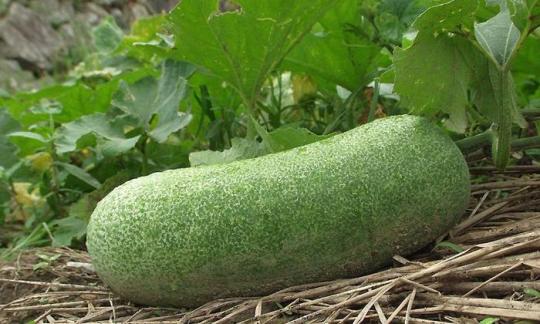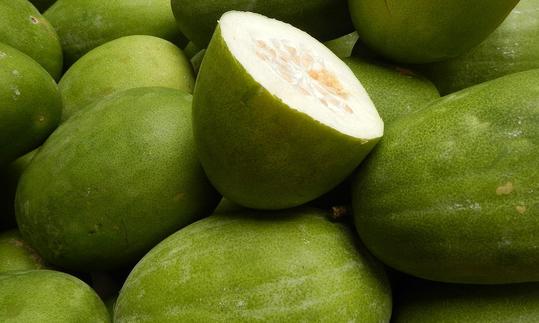Table of contents
Wax gourd ( Benincasa hispida), also called winter melon, can be eaten raw or cooked. Organic quality is hardly available in the DACH countries.
Use in the kitchen
What is a winter melon (wax gourd)? The winter melon is a vegetable with white, crisp, juicy flesh. The oval, light brown seeds should be eaten as they contain many valuable nutrients. Wax gourds can be prepared raw, boiled, steamed or fried. Young, slightly unripe specimens can be eaten with the skin. Older, ripe wax gourds require the tough skin to be removed. Cooked wax gourds have a slightly sweet taste, a soft texture and are almost translucent.
The size of the fruits varies greatly depending on the variety and ranges from small, egg-shaped specimens to long gourds weighing up to 20 kg.
Winter melon is mainly used in China, India, Korea and Japan. However, it is also popular in Thailand. In addition to the pulp, the young leaves and flower buds are also eaten cooked as vegetables. A well-known dish is winter melon soup (recipe below). As a vegetable, wax gourd can be prepared in a similar way to Hokkaido pumpkin, butternut squash or zucchini. In Indian cuisine, wax gourd is used with mung beans as dal or in curry dishes. Winter melon is also used to make desserts and cakes. So-called winter melon tea is popular. The pulp is cooked with brown sugar to make a syrup, which is then diluted with water.
Root vegetables such as onions, carrots, parsley roots, turnips and celeriac go well in stews or braised vegetables prepared with wax gourd. Herbs such as rosemary and parsley round off the dish. A smoothie made from winter melon, mixed with lemon, mint,pepper and salt is refreshing and therefore an ideal drink in summer.
Vegan recipe for winter melon soup
Ingredients (for 4 people): 2 spring onions, 1 handful of fresh coriander leaves, 2 cm ginger, 1 clove of garlic, 400 g winter melon, 100 g shiitake mushrooms, 1 l vegetable stock (with a little salt), 1 teaspoon soy sauce (tamari), 1 tablespoon dried goji berries.
Preparation: Wash the spring onion and cut into 1 cm thick rings. Wash the coriander leaves and chop roughly. Set aside a few spring onions and coriander leaves for garnish. Peel the ginger and garlic and chop finely. Peel the winter melon and cut into smaller pieces. Wash the shiitake mushrooms and chop finely.
Fill the pot with vegetable stock and add spring onions, coriander leaves, ginger and garlic, bring to the boil briefly. Add winter melon, shiitake mushrooms and soy sauce. Let the soup simmer gently for 20-30 minutes until the winter melon is translucent. Serve the soup in four plates or bowls and garnish with spring onions, coriander leaves and goji berries.
Vegan recipes with wax gourd (winter melon) can be found under the note: " Recipes that have the most of this ingredient ".
| Not only vegans or vegetarians should read this: Vegans often eat unhealthily. Avoidable nutritional errors. |
Purchasing - Storage
You cannot buy wax gourds (winter melons) in large supermarket chains such as Coop, Migros, Denner, Volg, Spar, Aldi, Lidl, Rewe, Edeka, Hofer, Billa. You also cannot find them in the standard range in organic supermarkets such as Denn's Biomarkt and Alnatura. You can usually buy winter melons in Asian shops or online shops, and you can also occasionally find them at seasonal weekly markets.
When buying, make sure that the skin is as intact as possible. The fruit should feel hard and have no dents. 14
The season for European wax gourd (Romania) is between the end of August and the beginning of October. 12 Wax gourds from tropical areas are also available in other months, as the shelf life is several months if stored properly.
The availability of wax gourd (winter melon) varies depending on the size of the store, catchment area, etc. Our recorded food prices for the DA-CH countries can be found above under the ingredient image - and by clicking on them you can see their development at various suppliers.
Storage tips
Whole wax gourds are protected by their wax coating. They can be stored dry for 4-6 months at 20 °C without any loss of taste or quality. Wax gourds do not tolerate temperatures below 13 °C. 5
Sliced wax gourds should be stored in the refrigerator and consumed within a few days.
Ingredients - Nutritional values - Calories
Raw wax gourds (organic) are very low in calories (13 kcal/100g). Their juicy flesh consists of 96% water. The carbohydrate content of 3 g/100g is low and consists almost entirely of fiber: 2.9 g/100g. They are practically fat and protein free. With 282 mg per 100 g, they have a high salt content. 1
100 g of wax gourd contains 13 mg of vitamin C, which corresponds to 16% of the daily requirement. Hokkaido pumpkin (12 mg) and tomatoes (14 mg) have comparable amounts. Sea buckthorn berries (450 mg/100g) and green chili peppers (242 mg/100g) contain particularly high levels of vitamin C. 1
0.11 mgriboflavin (vitamin B2) per 100 g corresponds to about 8% of the daily requirement. Passion fruit (0.13 mg) and aronia berries (0.10 mg) have similar contents. Other gourds contain much lower amounts of riboflavin, e.g. cantaloupe melons : 0.02 mg/100g, butternut squash : 0.04 mg/100g and Hokkaido pumpkin 0.06 mg/100g. 1 Good sources of riboflavin are mainly nuts, herbs, mushrooms and pulses.
Zinc is present in winter melons at 0.61 mg/100g, comparable to avocados and radicchio. Green beans have a multiple of this trace element at 4.5 mg/100g. 1
In addition, the winter melon contains small amounts of sodium, iron, magnesium and phosphorus. It also contains thiamine (vitamin B1) and niacin (ex vitamin B3). 1
The complete ingredients of raw wax gourd (winter melon), the coverage of the daily requirement and comparison values with other ingredients can be found in our nutrient tables. In the article Nutrients explained you will get a detailed insight into the topic.
Health effects
Wax gourd contains trace elements, vitamins and important secondary plant substances such as flavonoids, alkaloids, tannins and phenolic acids. These functional ingredients are involved in many biological functions and are, among other things, antioxidant, antibacterial and diuretic. They can also reduce the lipid concentration in the blood and blood sugar. 3
The seeds of the wax gourd have a higher antioxidant activity than the flesh, which is why they should definitely be eaten. 2,4 Its antioxidant capacity can also have anticarcinogenic effects. 4 Furthermore, in vitro have anti-inflammatory and analgesic effects. 3,4
In vitro, wax gourd extracts have been shown to inhibit ACE activity, which reduces cardiovascular problems and lowers blood pressure. This could be seen as pharmacological evidence for its use in the treatment of high blood pressure in traditional Chinese medicine. 4 In vivo studies on animals (rats) confirmed a blood pressure-lowering effect. Intravenous injection of wax gourd juice led to vasodilation and thus a reduction in blood pressure. Substances contained in the juice presumably stimulate the production of nitric oxide, which has a vasodilating effect. 6 In vitro studies show that wax gourd extracts inhibit LDL oxidation. Wax gourds could therefore have a protective effect against the development of atherosclerosis. 4
Dangers - Intolerances - Side effects
Allergic reactions to wax gourds are very rare. In a documented case from Japan (2022), a 4-year-old boy showed severe allergic reactions after eating wax gourd soup. Until he was 3 years old, no allergic reactions to wax gourd were known. A possible trigger for the allergic reaction could be the protein 23 kDa. This allergen comes from ragweed pollen ( Ambrosia artemisiifolia), also known as ragweed, which is why a cross-allergy is probably present. 7
Folk medicine - naturopathy
Traditional Chinese Medicine ( TCM) The dried peel is often used to make tea. It is used to relieve water retention in the lower abdomen, to promote diuresis (increased urine production) and to eliminate edema. 3 Wax gourd is also said to inhibit inflammation and lower blood pressure. 4
The flesh of the winter melon is considered 'cold' and is said to have a soothing effect in hot weather. 3
Ecological footprint - animal welfare
The ecological footprint of a food depends on various factors. The type of agricultural production (conventional vs. organic), seasonal, regional or domestic production or import by truck, ship or plane, different types of packaging and whether the goods are fresh or frozen all play a decisive role. 13
Despite extensive research, we were unable to find any precise information on the CO 2 footprint of wax gourds. We therefore show figures from other gourds from Germany: pumpkins have a relatively low footprint of 0.2 kg CO 2 eq/kg, while cucumbers have a footprint of twice as high at 0.4 kg CO 2 eq/kg. 13
The water consumption of pumpkins in general is about 336 l/kg, cucumbers have a similar consumption at 353 l/kg. 16
Worldwide occurrence - cultivation
The exact genetic center of wax gourd ( Benincasa hispida) is unknown. Its origin and domestication are thought to be in Southeast Asia. 11 Depending on the source, information can be found in the area of China and East India 3 or in the region of Indonesia and Malaysia. 11
Today, wax gourd is grown in almost all tropical, subtropical and temperate zones of Asia. 3 Larger cultivation areas are in China, India and Thailand, as well as in the Caribbean and the United States (especially Florida). 5,8 It is cultivated on a small scale in Africa and South America, 15 and Europe (including Romania 12).
The average yield from conventional cultivation in India is around 35-45 t/ha. 10
Cultivation - Harvest
Wax gourds (like other pumpkins) form tendrils several meters long. The annual climbing plant can either be left to grow on the ground like pumpkins or watermelons or it can be allowed to climb up trellises (bamboo frames or "tunnels").
The optimum temperature is 22-35 °C, the plant is sensitive to low temperatures, which is why it should not be planted too early. Winter melons prefer permeable, sandy loam soils that are rich in organic matter, but also tolerate other soils well. The optimum pH value of the soil should be between 6.5 and 7.5. During flowering or in very hot weather, wax gourds require regular watering. 10 It is a cross-pollinating plant, which is why it is important that bees and insects can pollinate the flowers. Alternatively, you can pollinate by hand with a brush. The yellow flowers can reach up to 20-25 cm in length, depending on the variety. 15
The fruits are ready for harvest after 120-150 days. 10 Wax gourds are often slightly hairy when unripe. Ripe fruits are surrounded by a thin, tough shell that is covered with a white layer of calcareous wax. On some varieties, fine hairs can still be seen even on ripe fruits. 9
Further information
Wax gourd ( Benincasa hispida Thunb. Cogn., Syn. Benincasa pruriens f. hispida), also called winter melon, is a plant species from the genus wax gourds ( Benincasa) within the gourd family (Cucurbitaceae). Individual varieties can produce fruits up to 80 cm long and weighing 20 kg. 8
The gourd family (Cucurbitaceae) also includes cucumbers such as the salad cucumber, melons such as the watermelon, cantaloupe melon, Galia melon and honeydew melon as well as pumpkins such as the butternut squash, Hokkaido pumpkin and also the zucchini.
Alternative names
Wax gourd is also called winter melon or wax cucumber. It should not be confused with the honeydew melon, which is also called winter melon. The English name is wax gourd, ash gourd, white gourd, winter gourd, winter melon, tallow gourd, ash pumpkin or Chinese preserving melon, sometimes also fuzzy melon.
Bibliography - 16 Sources
| 1. | USDA United States Department of Agriculture. |
| 2. | Huang HY, Chang CK, Tso TK, Huang JJ, Chang WW, Tsai YC. Antioxidant activities of various fruits and vegetables produced in Taiwan. Int J Food Sci Nutr. 2004;55(5):423-429. |
| 3. | Zhang M, Lei J, Wang Y, Zhang J, Liu D. Ethnopharmacology, phytochemistry and pharmacology of Benincasae Exocarpium: A review. Chin Herb Med. 2022;15(1):15-26. |
| 4. | Huang HY, Huang JJ, Tso TK, Tsai YC, Chang CK. Antioxidant and angiotension-converting enzyme inhibition capacities of various parts of Benincasa hispida (wax gourd). Food/Nahrung. 2004;48(3):230-233. |
| 5. | Sun X, Baldwin EA et al. Effect of Preprocessing Storage Temperature and Time on the Physicochemical Properties of Winter Melon Juice. Journal of Food Quality. 2022:3237639. |
| 6. | Nakashima M, Shigekuni Y et al. Nitric oxide-dependent hypotensive effects of wax gourd juice. J Ethnopharmacol. 2011;138(2):404-407. |
| 7. | Nagakura KI, Takei M, Sato S, Yanagida N, Ebisawa M. Anaphylaxis to winter melon due to cross-reactivity of sensitization to ragweed pollen. Pediatr Allergy Immunol. 2022;33(3):e13764. |
| 8. | Xie D et al. The wax gourd genomes offer insights into the genetic diversity and ancestral cucurbit karyotype. Nat Commun. 2019;10(1):5158. |
| 9. | University of Florida. Stephens JM. Wax Gourd, Benincasa hispida (Thunb.) cogn. |
| 10. | Sharma V et al. Ashgourd Cultivation: a Success Story. All India Co-ordinated research project for dryland agriculture. Regional research station for Kandi area. Punjab Agricultural University 2014. |
| 11. | Mini Raj N, Prasanna KP, Peter KV, Ash gourd: Benincasa hispida (Thunb). Cogn. In: Kalloo G, Bergh BO, Genetic Improvement of Vegetable Crops. Elsevier Ltd: Pergamon 1993,235-238. |
| 12. | Dobre C, Toma E, Dona I, General Aspects Regarding the Organic Cultivation of Wax Gourd in Romania. Agriculture and Agricultural Science Procedia 2015;6:661-665. |
| 13. | Reinhardt G, Gärtner S, Wagner T. Ökologische Fussabdrücke von Lebensmitteln und Gerichten in Deutschland. IFEU Institut für Energie - und Umweltforschung Heidelberg. 2020. |
| 14. | Thai-Thaifood de: Wachskürbis (Fak Keaw). |
| 15. | Arvay CG, Fruchtgemüse. Alte Sorten und aussergewöhnliche Arten neu entdeckt. Graz/Stuttgart: Leopold Stocker Verlag; 2011, 106-107. |
| 16. | Mekonnen MM, Hoekstra AY. The green, blue and grey water footprint of crops and derived crop products. Hydrol. Earth Syst. Sci. 2011; 15: 1577-1600. |













Comments